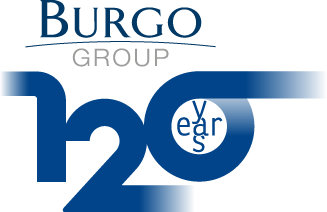HSE: Safety management and environmental protection
To manage safety at work and environmental protection, the HSE area of the Group has an up-to-date and well-placed team in all sites. The activities of the HSE department involve all the processes, from maintenance to transport, thus resulting in a complex system that requires the direct participation of staff. Initiatives for the protection of workers are accompanied by the ongoing implementation of certification standards for the occupational safety and environmental management system, to drastically lower injuries and promote a circular economy model. In this interview, Valerio Forti, the HSE director of Burgo Group, answers a few questions about the role of the HSE department in the company.
Which activities are carried out by the HSE unit inside Burgo Group?
The HSE area is one of the central departments of Burgo Group and oversees all the issues related to health, safety, and the environment in the workplace. Said purposes originate from a strong corporate will to combine all such activities in one single function, to coordinate the effort between the companies and the sites of the group.
The management of the HSE area, and therefore of all aspects related to safety and the environment, is essential for the company. Equally essential are the people who work in this area, even at different locations. In particular, the HSE managers of the individual plants must have special skills, that are first of all of a technical nature.
The knowledge of a very complex and constantly evolving specific legislation is essential, but the most important elements are the soft skills that people in this role must possess. The main prerogative is to promote a real cultural change in the company, towards a culture that is increasingly focused on all-around prevention.
The people involved must be capable of communicating with the organization at all levels, from top management to workers, to motivate and involve everyone in our initiatives.
A lot depends on specific technical aspects, obviously, but even more influential are the communication and relationship components, which are crucial for the successful implementation of our policies regarding health, safety, and the environment.
What are the facilities involved in the HSE activity?
The subject of HSE concerns all Burgo Group's activities: from the production department, and therefore all the production sites of the company, to the administrative offices.
All related activities, like at the warehouse, involve not only Burgo Group employees, but also external companies that work with us on-site, for example workers involved in maintenance activities, supply of services, and transport.
The HSE involves all the production and all the assets. I would say that no area is excluded from this type of process, which is a cross-disciplinary process and must be taken over and managed in every activity that is carried out at the company level.
So, the global aim is to provide integrated protection of these aspects for the people who work for Burgo, not only the employees but also the people who are involved in the daily routines, in the production and delivery of our products.
Speaking of the topic of safety, in 2021 we launched a program called Go Safety. This is a behavioural audit program that sees the direct participation of the personnel of the individual sites, regarding specifically the compliance to safe practices.
The purpose is not to have a supervisory activity, but rather to provide constant monitoring and steady feedback to correct unsafe behaviours, and to promote a culture of safety that shall result in a sort of "common standard" for everyone.
The idea is to get everyone in the organization to operate and think about safety the same way. Now we have started with small groups of observers, but the idea is to obtain an increasingly interdependent safety culture, in which each of the workers or people who work within the Burgo Group takes care of their own safety first, but also of the safety of others.
This is indeed the interdependent culture model that can help us make a difference and bring a great improvement not only in safety performance but in the company performance too.

Burgo Group is committed to preventing workplace accidents and occupational diseases, thus guaranteeing a healthy and safe working environment for all its employees.
The HSE sector is constantly evolving: what are the activities you envision in the short, medium, and long term?
The main actions and commitments of the Group go first of all in the direction of a definite reduction of work-related accidents. If we look at the data from the last 10-15 years we can see a significant improvement, with a 70% reduction in the number of injuries.
These are comforting data, but compared to our aim they are still not enough. Our idea is to pursue what should be the target or rather the goal of each company: to lead a business with zero occupational accidents, in which an injury is not part of the business reality, but rather something that must be prevented in any way.
From the management system perspective, we focus on international standards that should ensure the application of the best standards, thus enforcing the best management practices, and also the best operational practices.
This is the reason why we have pursued the implementation of certification standards for the environmental management system: ISO 14.001 and EMAS. We have also recently started the certification of our health and safety management system in the workplace, according to the international standard ISO 45.001.
If we consider safety or the environment more generally, we have more than 200 well-defined goals among the various sites. The goals are very specific too, such as actions to mitigate environmental issues or improve the management in terms of reduction, for example, of water consumption, which is an important environmental aspect for us, or the improvement of waste management, or the reduction of certain kinds of waste.
Our vision is to truly create an organized system with procedures, good practices, and an organizational structure that partakes fully in the achievement of results. In particular, we aim to create a new culture that will allow us to manage things more effectively and efficiently, with a strong focus on constant improvement.
How does the Burgo Group address the issue of the circular economy?
The circular economy is a topic of great importance to Burgo Group, but I would say it should be so for all companies. The circular economy is certainly one of the pillars of the current ecological transition and it will be an increasingly crucial matter in the forthcoming years.
Burgo Group is a partner of the Circular Economy Network, that brings together organizations and associations with the aim to promote issues linked to the circular economy.
Partaking in these events is vital to make society and institutions perceive the importance of the circular economy and the tools that we need to launch a truly circular economy. We are talking about a fully integrated economy, that does not only create a model of production of goods, consumption, and disposal of waste but a virtuous circle that feeds itself: an economy that "recycles" itself.
Burgo Group is very active in this area, for example giving new value to by-products that can thus become materials to be used in a different production cycle.
Burgo is also very active with conversion projects, like in our Avezzano paper mill, which saw the conversion of the production plant from the use of virgin fibre, cellulose, to a completely recycled material. All of this is, without a doubt, part of the backbone of our circular economy project.

